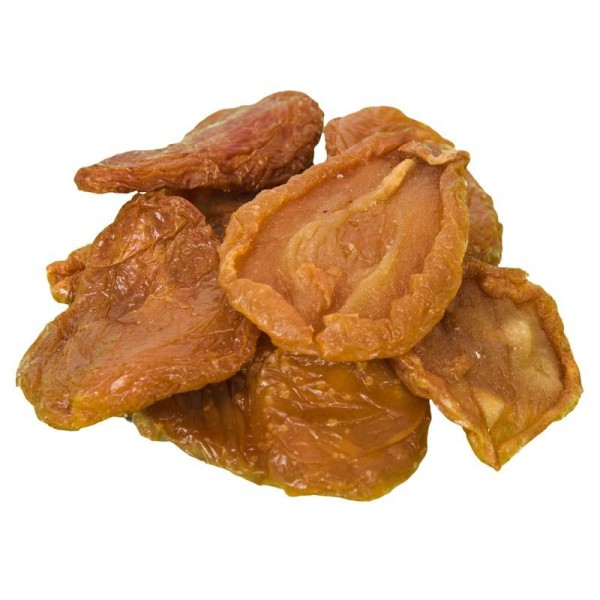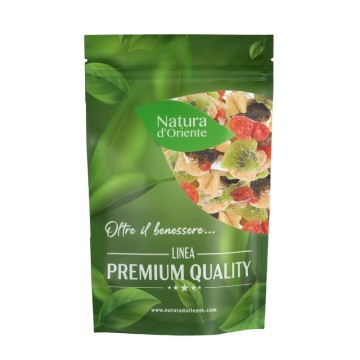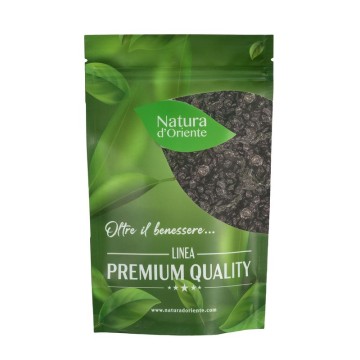Dehydrated dried pears
Dried pears are a tasty snack, perfect on the go and for a wellness break. Yes, because these dehydrated fruits contain several beneficial principles for our body. In dried pears, the dehydration process that removes water concentrates some of the nutrients such as amino acids and fiber.
These dried fruits contain phytonutrients important for our well-being, such as antioxidants and flavonoids, which provide significant health benefits.
The potential health benefits of dried pears start from their help to the digestive system, thanks to the fair amount of fiber, essential for proper digestion and for the prevention of constipation.
Soluble fiber feeds healthy bacteria in the gut, which are considered prebiotics associated with healthy aging and improved immunity.
The fiber in dried or dehydrated pears also helps lower LDL cholesterol (bad cholesterol) and helps the body counteract the risk of heart disease.
Since dried pears are an excellent source of potassium, they can also help the body reduce the risk of developing episodes of high blood pressure. Their content of antioxidants known as plant phenols, helps the immune system by fighting free radicals that can cause cell damage.
The flavonoid antioxidants , in particular, counteract inflammation in the body while other similar substances are present for cellular health, including beta-carotene, lutein and zexanthin. In particular, the latter two compounds are useful for the well-being of sight.
Dehydrated dried pears are rich in vitamin K, and several other vitamins such as A, C, and those of Group B (vitamins B1, B2, B3, B5 and B6).
They also make available various minerals and in particular Calcium, Potassium, Iron, Copper and Magnesium.
As a fruit, the pear is also rich in important active ingredients such as lignin, sorbitol and pectin - very useful for digestion.
Finally, pear is low in calories, even in the dehydrated pear version, and has a low glycemic index (it does not increase blood sugar quickly) - for this reason it can be included in the diet of diabetic subjects.
Origins and History of cultivation
 The pear is a fruit that boasts its origins in prehistoric times, probably from the regions of south-eastern Europe and those of western Asia.
The pear is a fruit that boasts its origins in prehistoric times, probably from the regions of south-eastern Europe and those of western Asia.
In practice, it can be defined as a typically Mediterranean fruit, which was already part of human nutrition for 4000 years. We know that already in the third century BC pear cultivation was quite common in Magna Graecia.
The famous poet Homer considered the pear a healthy and appetizing fruit, loved by the gods of mythology and by Greek heroes.
In Roman times, there are testimonies of Cato and Pliny on the cultivation of pears and on the known varieties of pears. It was a highly regarded and consumed fruit, and over the centuries it has acquired more and more prestige, as an important complement to the table.
The pear has been present as a worldwide fruit and vegetable crop since ancient times, and still today there are thousands of pear plantations, which involve a large market both in Europe and in other continents.
The varieties of pears are now very numerous, and even the pear is among the fresh fruit that has the greatest number of varieties produced and sold.
Plant and Fruit
The pear plant, Pyrus communis, is the wild one that gives rise to all subspecies, while the fruit grown pear is usually designated as Pyrus communis sativa.
Despite their wide geographical distribution, the various species of the genus Pyrus do not present great barriers of incompatibility. In addition, high morphological diversity and lack of distinctive traits between species have been reported.
Generally, in most species the Pyrus communis is a deciduous tree with a large oval crown, or occasionally a shrub. It usually varies in height from 5 to 30 meters, and can be different from species to species in the leaves, the presence or absence of thorns, and especially in the size, shape and taste of the fruit.
Plants often form dense thickets, and used not only for fruit but also for timber, which is valued by cabinetmakers, and available in small quantities.
The plant is very resistant to drought and cold, tolerates temperatures as low as -20 ° C
when dormant, and prefers well-drained soil in full sun - when in light shade, it doesn't bear fruit as well. It grows well in clay soils, avoiding the more acidic ones.
The fruits in the well-known "pear" shape, in fact, are long in a variable way and also the color changes according to the variety - which are many, from the classic Abate pears, to the Kaiser, up to the well-known William pears, Coscia, Conference, etc.
Nutritional values of dehydrated pears
Pears dehydrated in the face of various nutritional substances, have a low calorie content compared to other types of dried fruit - 307 kcal per 100 grams. They contain very little fat (1.1%), provide minerals, vitamins, fibers (about 8 g / 100 g), proteins (1.7 g / 100 g).
Even in the sliced dried version, minerals such as calcium, potassium (about 530 mg / 100g), calcium (about 34 mg / 100 g), zinc (about 0.39) are made bio-available in the pear. mg / 100 g), magnesium (about 33 mg / 100 mg), phosphorus (about 59 mg / 100 g), copper (about 0.37 / 100 g) and iron (about 2 mg / 100 g) .
The values of the dried pear show good contents of vitamin A (about 3 IU / 100 g), vitamin C (about 7 mg / 100 g) and vitamin K (about 20 µg / 100 g), Vitamin B-2 ( 0.14 mg / 100 g), Vitamin B3 (1.37 mg / 100 g), and Vitamin B-5 (about 0.15 mg / 100 g).
It also contains, per 100 grams, substances such as Vitamin E (about 0.06 mg), lutein and zeaxanthin.
How to consume dehydrated pears in the kitchen or as a snack
Dehydrated pears are sweet and excellent as snacks rich in well-being and low in fat . The snack portions of the dried dehydrated pear slices are perfect to be enjoyed between meals, or as a healthy food before and after sports training.
In addition to the hunger-breaking effect in diets, in fact, dried pears are ideal for replenishing mineral salts and vitamins, even in yogurt, smoothies, mix of dried fruit and cereals.
You can use dried pears for top decorations of ice cream, cupcakes, muffins, cakes and other pastry specialties.
The dehydrated pear slices can be ingredients for energy bars, or to flavor tea and infusions. Likewise, they can decorate and flavor drinks and beverages.
Dehydrated dried pears: side effects and contraindications
While dried pears may offer health benefits, they also have some drawbacks. In addition to the recommended daily intake of fruit, the high sugar content can pose health risks for those with diabetes, or must keep blood sugars under control.
Dried pears may also cause laxative effects, if taken in excessive quantities, with possible irritable bowel effects.











 No reward points for this product.
No reward points for this product.
 The pear is a fruit that boasts its origins in prehistoric times, probably from the regions of south-eastern Europe and those of western Asia.
The pear is a fruit that boasts its origins in prehistoric times, probably from the regions of south-eastern Europe and those of western Asia.















